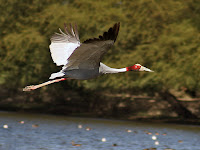Sarus
crane flying by J.M. Garg and close up of head by unknown.
Sarus
cranes prefer to live in mixture of partially flooded areas to live in as they
feed on roots, tubers, invertebrates and amphibians. They also need dry land
nesting as Sarus cranes make their nest out of reeds and grassed which is at
least two meters in diameter and above the shallow water surrounding it (Birdlife
international, 2016). The mating ritual of the Sarus crane involves dancing,
bowing, circling movements and loud shrill cries. This species of crane is monogamous
which means they mate for life and will grieve if their mate is killed,
refusing to eat or care for itself (Hammer, 2009).
Displaying wings by
J.M. Garg & family by Sumeet Moghe.
Next time, we will be covering a species of humming bird
named after Anne Debelle, Duchess of Rivoli.
References
BirdLife International. 2016. Antigone antigone. The IUCN
Red List of Threatened Species
2016: e.T22692064A93335364.
Campbell, I, & Woods, S 2013, Wildlife of Australia,
Princeton University Press, Princeton. Available from: ProQuest Ebook Central.
[7 May 2019].
Gosai, K.R., Shrestha, T.K., Shrestha, S.M., Hill, S.D.,
Gyawali, B., Gautam, D.N. & Aryal, A. 2016, "Population structure,
behavior, and current threats to the sarus crane (Grus antigone antigone) in
Nepal", Journal of Asia-Pacific Biodiversity, vol. 9, no. 3, pp. 301-305.
HAMMER, N., Centrum för teologi och religionsvetenskap,
Centre for Theology and Religious Studies, Lund University & Lunds
universitet 1887;2009;, "Why Sārus Cranes epitomize Karuṇarasa in the
Rāmāyaṇa", Journal of the Royal Asiatic Society, vol. 19, no. 2, pp.
187-211.
Picture references




No comments:
Post a Comment